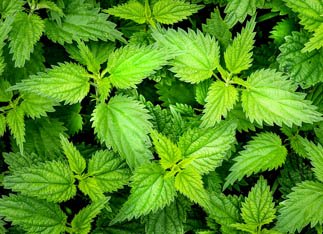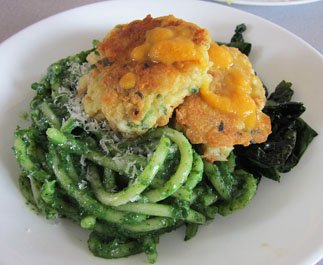Stinging nettle Nutrition facts
Stinging nettle is a springtime abundance when foragers look forward to enjoying its young shoots, either cooked as a potherb or a restorative and energizing tea made from the leaves.
Botanical name: Urtica dioica. Common Name: Stinging nettle, tall nettle, California nettle, etc.
 |
| Stinging nettles. (Photo: svklimkin) |
Stinging nettle is a perennial herb with opposite deep green leaves with serrated edges and tiny greenish flowers. It grows ubiquitously in temperate climates by riversides, streambeds, and in forests, and farmlands.
Nettles prefer fertile, moisture-rich soil to flourish. It is an erect, perennial plant with branching roots and bristly stems growing up to 6-9 ft tall. Lanceolate leaves and square stems are covered with stinging hairs. Tiny yellow-green flowers, females hanging like catkins, males in spikes appear in summer.
Leaves are gathered before flowering; used fresh or dried in the sun. Nettle foragers usually gather them from February to May when they are young and tender.
Its young shoots and leaves are valued for nutritious food and in medicine for improved digestion and rejuvenator.
Harvesting
Handling nettles with bare hands does elicit serious sting; should be gathered carefully with the help of the right tools. Foragers use either gloves or scissors and a basket/thick bag.
Avoid harvesting nettles from roadside, hedges, or industrial sites because they can absorb harmful minerals and pollutants from the soil.
Cut the stem with scissors or gloved hands and place them in a large bag or basket.
For drying, secure nettle stalks with a rubber band and hang them upside down in a dark dry place. Strip the leaves once the nettles are completely dry and crispy. Use gloves and run pinched fingers up the stem to strip.
Health benefits of Stinging nettle
Stinging nettle is one of the moderate-calorie leafy vegetables. 100 g of cooked leaves hold 42 calories.
They are a storehouse of several vital phytochemicals, anti-oxidants, vitamins, and minerals that immensely benefit overall health and wellness.
Phytonutrients and antioxidants in the drumstick leaves play an important role that helping reduce some diabetes symptoms, protecting cardiovascular and liver health, and supporting brain health.
Nettle greens are one of the excellent sources for vitamin-K; 100 g provides 499 µg (about 416% of recommended intake). Vitamin K has a potential role in bone health by promoting osteoblastic (bone formation and strengthening) activity. Adequate vitamin-K levels in the diet help limit neuronal damage in the brain; thus, has an established role in the treatment of patients who have Alzheimer's disease.
Fresh leaves are a rich source of folates. 100 g of fresh greens contain 40 µg or 10% of folates. Folic acid helps prevent neural tube defects in newborns when advised in anticipant mothers.
Nettles contain 2010 IU of vitamin A, 1150 µg of β-carotene, 4180 µg of Lutein-zeaxanthin/100 g. Research studies suggest that vitamin-A and flavonoid compounds in green-leafy vegetables improve vision, and help protect against skin, lung, and oral cavity cancers.
Stinging nettle are abundant in the B-complex group of vitamins such as thiamin, riboflavin, niacin, vitamin B-6 (pyridoxine), and pantothenic acid that are essential for optimum cellular enzymatic and metabolic functions.
Nettle greens are also an excellent source of minerals, especially calcium, magnesium, phosphorus, and iron. They pack a small amount of other essential minerals and electrolytes such as potassium, manganese, selenium, and zinc.
Medicinal benefits of stinging nettle
In Canada and the European Union, nettle leaf is regulated as an active ingredient of licensed natural health products (NHPs).
It is used as Traditional Herbal Medicines (THM's) as a
diuretic,
supportive therapy to help relieve rheumatic complaints,
nutritive tonic, and
to help relieve seasonal allergies like eczema.
| Principle | Nutrient Value | Percent of RDA |
|---|---|---|
| Energy | 42 Kcal | 2% |
| Carbohydrates | 7.49 g | 5.75% |
| Protein | 2.71 g | 5% |
| Total Fat | 0.11 g | <1% |
| Cholesterol | 0 mg | 0% |
| Dietary Fiber | 6.9 g | 18% |
| Vitamins | ||
| Folates | 14 µg | 3.5% |
| Niacin | 0.388 mg | 2.4% |
| Pyridoxine | 0.103 mg | 8% |
| Riboflavin | 0.16 mg | 12% |
| Thiamin | 0.008 mg | <1% |
| Vitamin A | 2010 IU | 67% |
| Vitamin K | 499 µg | 416% |
| Electrolytes | ||
| Sodium | 4 mg | <1% |
| Potassium | 334 mg | 7% |
| Minerals | ||
| Calcium | 481 mg | 48% |
| Copper | 0.076 mg | 8.4% |
| Iron | 1.64 mg | 23% |
| Magnesium | 57 mg | 14% |
| Manganese | 0.779 mg | 34% |
| Phosphorus | 71 mg | 10% |
| Zinc | 0.34 mg | 3% |
| Phyto-nutrients | ||
| Carotene-ß | 1150 µg | |
| Carotene-α | 114 µg | |
| Lutein-Zeaxanthin | 4180 µg |
Selection
Wild-food enthusiasts gather fresh nettles during the spring from nearby woods, in a way similar to ferns, morels, etc. Oftentimes fresh nettles are sold in the farmer's markets during the season.
In the North-West US and British Colombian Canada, each year foragers look forward to springtime and head towards the forest to gather fresh, tender nettles.
Choose fresh, crisp, bright green nettle leaves in tiny bundles. Avoid sunken, dry, yellow, and bruised leaves as they are out of flavor.
To preserve nettle leaves for tea or seasoning, gather leaves that are clean. Hang them in tiny bundles and dry them under the shade till they appear shriveled and crumble and crushed.
Storage
At home; store fresh, un-washed leaves inside a perforated plastic bag in the vegetable drawer.
Cooked nettles may be frozen and preserved for later use.
Store dry leaves whole or slightly crumbled in a dry place like a glass jar or a plastic bag out of direct sunlight.
Preparation and serving methods
Stinting nettle young shoots and leaves are widely used in spring soups and as a green vegetable.
To prepare, rinse nettles in a colander to remove dirt and debris. Cooking removes the stinging character of nettles and allows them to be consumed safely.
Here are some serving tips:
 |
| Nettle pasta with salted cod. (Photo: Eugene Kim) |
Add cooked nettles to quiches, casseroles, meat-pies, egg scrambles, meatloaf, lasagna, etc.
Blend cooked nettles to a thin paste in a blender with toasted pine/hazelnuts, olive oil, lemon juice, and spices to prepare classic nettle leaf pesto.
Enjoy nettle pesto over toasts, in pasta or meat and seafood dishes.
Enjoy stinging nettle in mouth-watering risotto.
Nettle tea is a favorite springtime drink, enjoyed for its freshness as well as health benefits. Cleaned nettles are boiled for 3-5 minutes and drink while hot.
Dried nettles are used in tea infusions and are a delicious addition to soups, sauces, and chutneys.
Safety profile
Nettle bristles inject inflammatory substances like histamine when handled with unprotected hands. The result is swelling, redness, and itching of body parts that came in contact with the nettle sting.
Put ice over the itching part and take anti-histamine drugs or consult your family physician for serious stings.
Because of their high vitamin-K content, patients taking anti-coagulants such as warfarin are encouraged to avoid this food since it increases the vitamin-K concentration in the blood which is what the drugs are often attempting to lower. This effectively raises the effective dose of the drug. (Medical disclaimer).
Also read ≻≻-
≻≻- Dandelions nutrition facts.
≻≻- Arugula (Salad rocket) nutrition facts.
≻≻- Back to Vegetables from Stinging nettle. Visit here for an impressive list of vegetables with complete illustrations of their nutrition facts and health benefits.
≻≻- Back to Home page.
Further Reading:
USDA - Nutrient Database for Standard Reference.
Stanford School of Medicine Cancer information Page-Nutrition to Reduce Cancer Risk.
Urtica dioica- Extension Gardener- North Carolina plant toolbox- PDF.